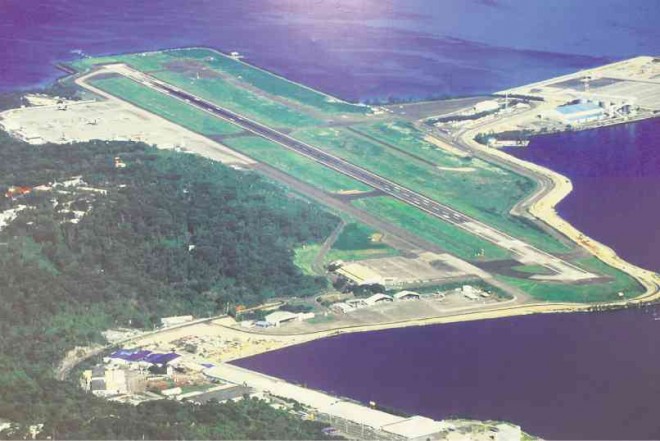
A WALL poster at the Subic Bay International Airport, formerly known as US Air Station, shows an aerial view of the site where combat planes of the Philippine Air Force will be stationed as the country readies a section of this free port in Zambales as a military base. PHOTO REPRODUCTION BY ALLAN MACATUNO
BUILT BY the Americans during the Korean War in the 1950s, the former United States naval air station in Cubi Point provided vital support to the US Seventh Fleet when the Subic naval base operated.
At that time, the air station was also operated as a repair and maintenance facility for about 400 carrier-based aircraft of the US Seventh Fleet for years until the Mt. Pinatubo eruption buried the station under tons of ash on June 15, 1991.
It only took less than a month for US Navy troops to restore the facility’s normal operations but three months later, the Philippine Senate voted to require the US military to withdraw all of its facilities in the country.
After the American troops left the country in 1992, their air station at Subic was rehabilitated under former Sen. Richard Gordon, who served as the first chair of the Subic Bay Metropolitan Authority (SBMA).
It was called Cubi Point International Airport during that transition, but eventually renamed as Subic Bay International Airport (SBIA).
More than two decades later, the Philippines will rehabilitate this facility to house a squadron of combat planes of the Philippine Air Force (PAF) as the country readies a section of this free port to become a military base.
Roberto Garcia, SBMA chair and administrator, said 12 lead-in fighter jets that the government bought from South Korea would be stationed in the SBIA.
“The PAF will rehabilitate a 13-hectare portion of the SBIA so this facility will become a mix of military and commercial airport,” Garcia said. The airport’s runway spans 2,744 meters x 45 meters.
The new PAF facility will operate at the former Federal Express (FedEx) terminal inside the SBIA.
Garcia said the government would have to fund the restoration of the portion of the SBIA that is dedicated to PAF.
“I told them (PAF officials) that they have to shoulder the expenses for the rehabilitation since our military has its modernization budget,” Garcia said.
Ports and wharves
Aside from the air station, the military is also set to use various ports and wharves as it establishes its military base inside the free port.
IN THIS 2013 photo, US military aircraft used in joint exercises with Philippine troops that year are parked at the Subic Bay International Airport. INQUIRER PHOTO
The Alava Pier, Juliet Pier, Bravo Wharf and Rivera Wharf will be the home ports of the Philippine Navy fleet, Garcia said.
At present, Subic Bay serves as the home port of frigates BRP Alcaraz (PF-16) and BRP Gregorio del Pilar (PF-15), the recent additions to the Philippine Navy fleet.
“This free port will be a forward operating base of our military. This place is the closest area to the source of potential conflict,” Garcia said, referring to China’s incursion in the West Philippine Sea where the disputed Scarborough Shoal or Bajo de Masinloc is located.
The shoal is about 222 kilometers (120 nautical miles) west of Subic Bay. It was the site of the tense stand-off between the Philippines and China in 2012.
Chinese fishermen were found by Philippine authorities to have illegally collected corals, live sharks and giant clams near the shoal. An attempt to arrest the fishermen was made but Philippine authorities were stopped by Chinese maritime surveillance ships.
Once the government establishes a military and naval base here, US troops would regularly come here for training, Garcia said.
“The US will not have a permanent base here but they will use our military facilities. US troops will train here on a rotational basis,” he said.
Garcia said about 1,000 US soldiers are expected to arrive here every six months if the Supreme Court issues a favorable ruling on the Enhanced Defense Cooperation Agreement (Edca).
‘At risk’
The Edca, signed between the US and Philippine militaries last year, allows the US to expand its presence in the country by building its own facilities and storing its assets in selected Philippine military bases.
“The presence of US troops here is a very strong deterrent [against China],” Garcia said.
He said the country is “at risk” in terms of military defense without the help of the US. “Just imagine if there will be no Americans here. We really have to make a stand and get help from our allies,” he said.
The Bagong Alyansang Makabayan (Bayan) criticized the government’s move to reopen Subic as a military base and asked the Senate to investigate the lease agreement between the Armed Forces of the Philippines and SBMA on the use of several facilities at the former US naval base.
“The Senate must investigate the 15-year lease agreement between the AFP and SBMA and analyze this within the context of the Edca and the US pivot,” Bayan said in a July 19 statement
“The Filipino people must protest this circumvention of the Constitution and violation of our sovereignty,” it added.
But Garcia shrugged off Bayan’s statement, saying SBMA has to cooperate with the national government “to preserve national security.”

